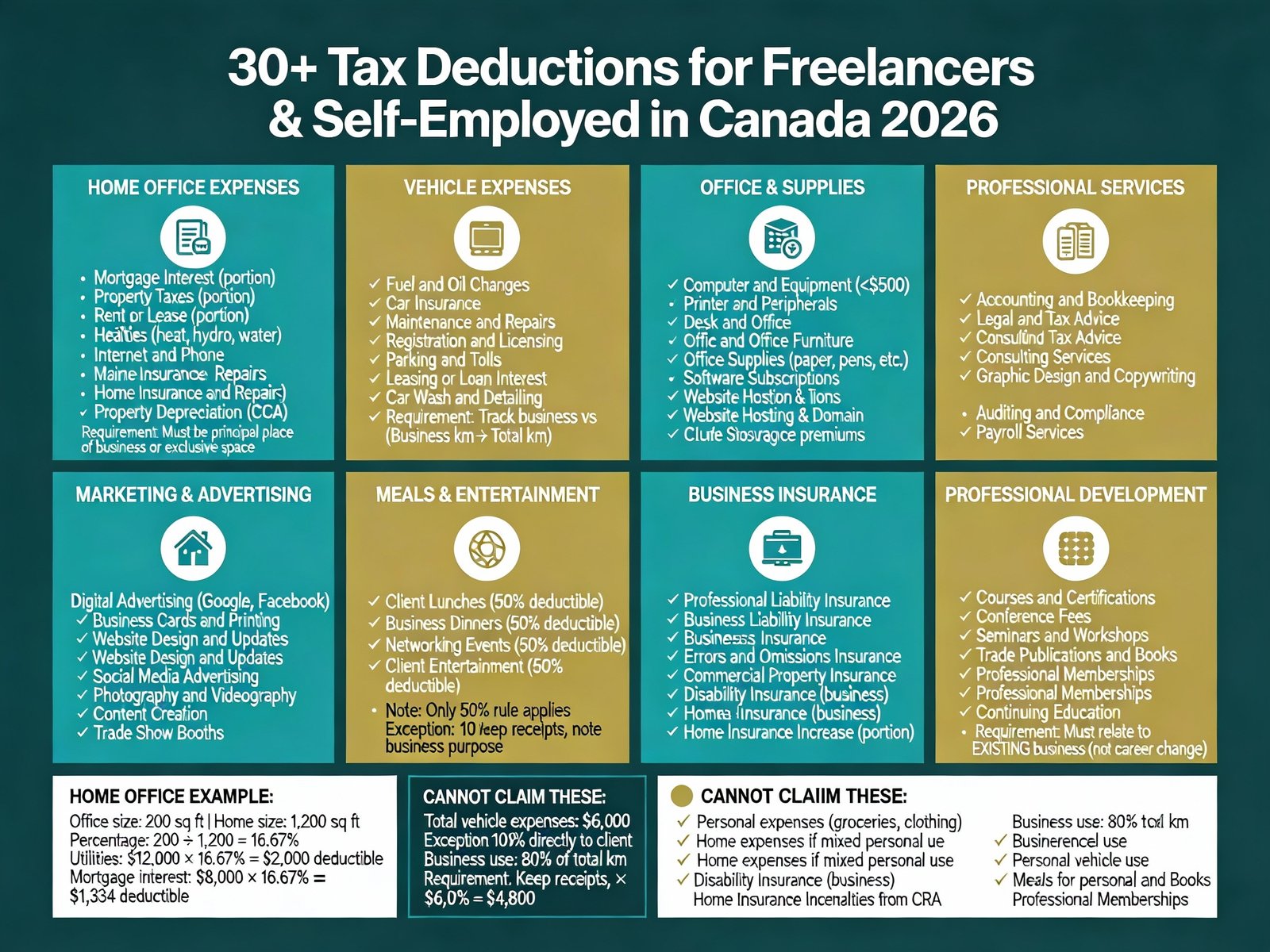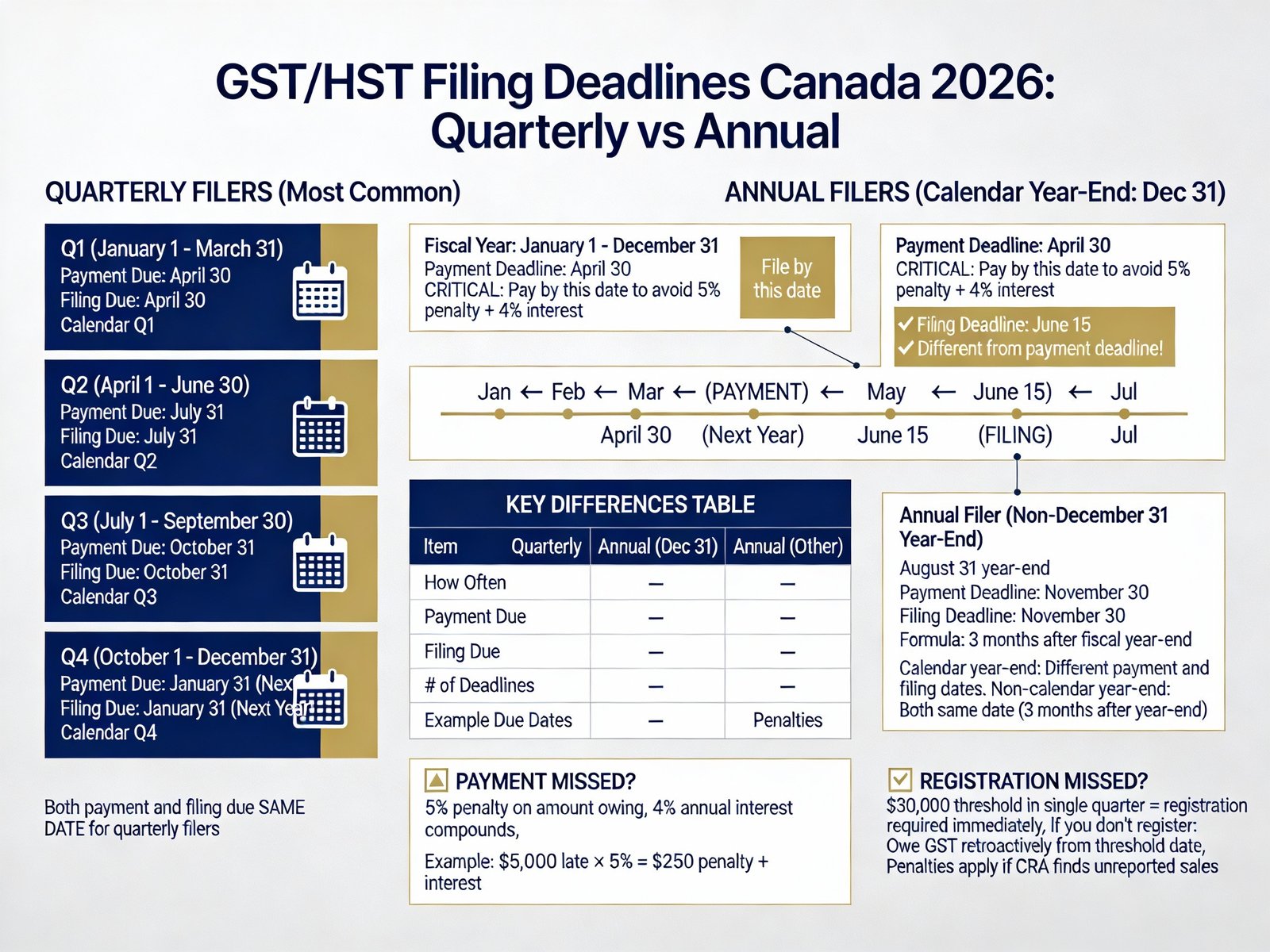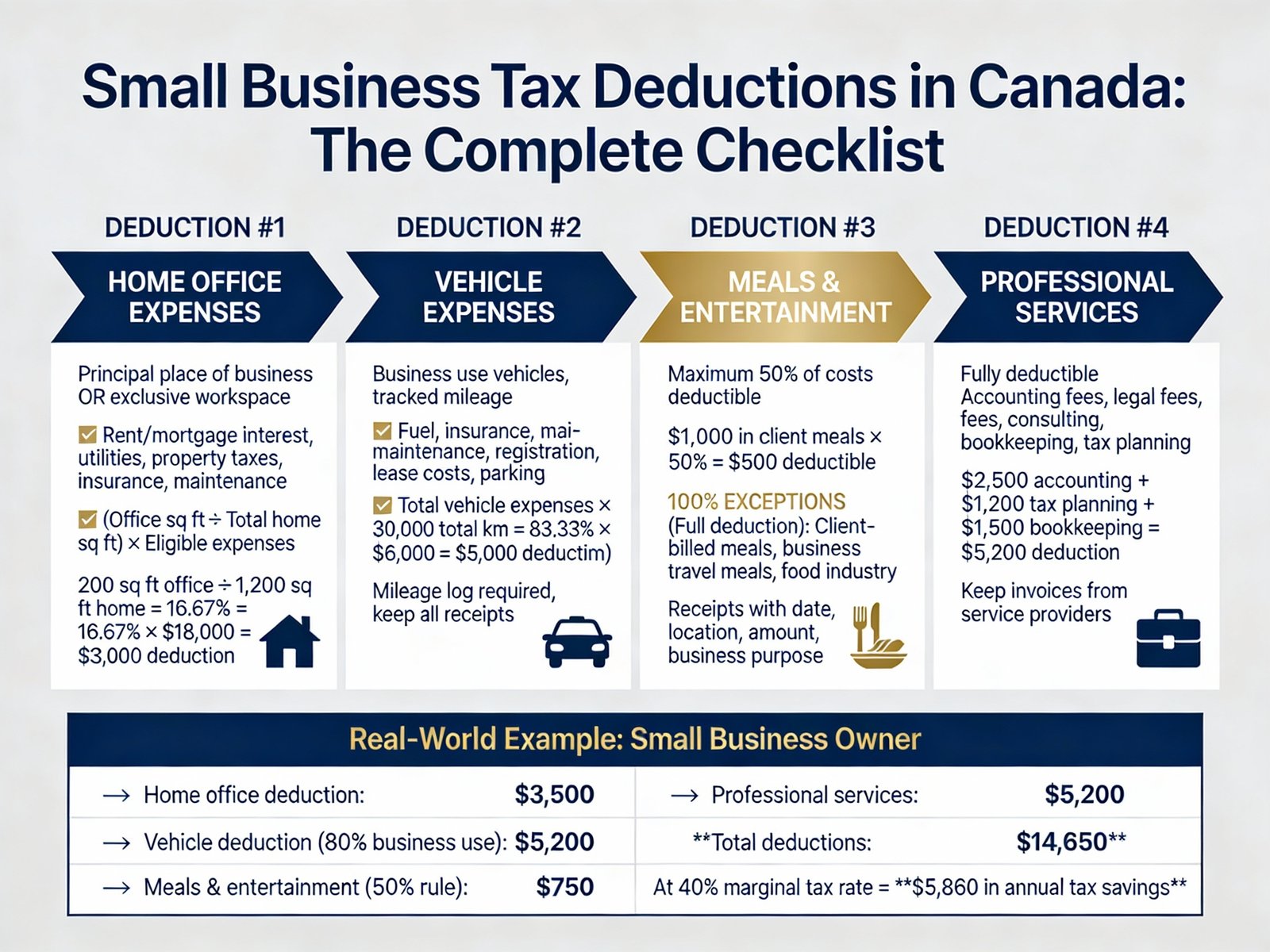Unfiled tax returns in Canada come with a steep price tag that grows with each passing day. The Canada Revenue Agency (CRA) charges a late-filing penalty of 5% of your unpaid balance, plus 1% for every full month your return remains outstanding (up to 12 months). Furthermore, if you’ve been late in previous years, these penalties can double to 10% of your balance plus 2% per month, for up to 20 months.
What happens if you file taxes late in Canada? Beyond the immediate penalties, the financial burden increases relentlessly. The CRA applies negligence penalties, interest on unpaid installments, interest on unpaid taxes, and even interest on the penalties themselves. In fact, your tax debt for each year in arrears can double every eight years. This mounting financial pressure is just the beginning of a cascade of consequences that can seriously impact your financial wellbeing.
However, not filing your tax returns doesn’t protect you from owing money. It usually means you’re missing out on opportunities to reduce your tax bill while risking further penalties or legal action. The CRA has sophisticated systems in place to track down those who aren’t paying their taxes, and with technological advancements, it’s becoming increasingly difficult to avoid your tax obligations for multiple years.
In this comprehensive guide, we’ll explore the hidden costs of unfiled tax returns in Canada, from financial penalties and legal risks to missed benefits and practical solutions for getting back on track with the CRA.
The Real Cost of Not Filing Taxes in Canada
Neglecting your tax filing obligations comes at a steep financial cost. The Canada Revenue Agency (CRA) imposes significant penalties that increase the longer you delay. Let’s examine what these penalties actually mean for your wallet and financial wellbeing.
Late filing penalties and interest charges
When you miss the tax filing deadline and owe money, the CRA immediately applies a late-filing penalty of 5% of your unpaid balance, plus an additional 1% for each full month your return remains late, up to a maximum of 12 months. This means your tax debt can increase by up to 17% just from penalties alone.
The situation becomes more severe for repeat offenders. If the CRA charged you a late-filing penalty in any of the previous three tax years (2021, 2022, or 2023) and issued a formal demand for a return, your late-filing penalty jumps to 10% of your balance owing, with an additional 2% for each month your filing is late, up to a maximum of 20 months. Under these circumstances, penalties could escalate your tax debt by up to 50%.
Beyond these penalties, the CRA charges compound daily interest on any unpaid amount starting the day after the balance is due. The interest rate fluctuates quarterly based on prescribed interest rates, making your debt a moving target that grows continuously.
Consider this scenario: on a modest tax debt of CAD 20,900.40, being just one day late would result in an immediate CAD 1,045.02 penalty. As days turn into months and possibly years, these charges accumulate rapidly.
How CRA calculates your debt over time
Tax debt grows relentlessly through a combination of several factors: negligence penalties, late filing penalties, interest on unpaid installments, interest on unpaid taxes, and interest on the penalties themselves. This creates a compounding effect that can be devastating to your finances.
According to tax experts, under standard CRA practices, your tax debt applicable to each year in arrears can be expected to double approximately every eight years. This exponential growth makes ignoring tax obligations one of the most financially destructive decisions possible.
Late filing penalties and gross negligence penalties are classified as “hard” penalties, meaning they’re particularly difficult to dispute if the facts aren’t in your favor. Additionally, when your installment interest charges exceed CAD 1,393.36, the CRA may charge an installment penalty under section 163.1 of the Income Tax Act.
The CRA may also impose a penalty if you fail to report income equal to or greater than CAD 696.68 that should have been included in your tax return, and this happens in any of the three previous tax years. This penalty can equal 10% of the unreported amount or 50% of the difference between the understated tax payable and the amount of tax withheld related to the unreported amount, whichever is less.
Impact on your credit and borrowing ability
Although owing taxes to the CRA doesn’t directly appear on your credit report due to privacy policies, the situation changes dramatically if collection efforts escalate.
When standard collection attempts fail, the CRA can certify your debt with the Federal Court or obtain a judgment from a provincial court confirming the amount owed. This court judgment becomes a matter of public record and can appear in the legal section of your credit report, where it remains for six to seven years, depending on the credit bureau and province.
The CRA possesses collection powers that far exceed those of ordinary creditors. Unlike other creditors who require court orders, the CRA can directly garnish your wages, place liens on your property, or freeze your bank accounts without judicial approval. These actions can significantly impact your credit score if they involve legal proceedings that become public.
Even without a direct credit report impact, major financial institutions often request proof that your taxes are current when you apply for a mortgage or substantial loan. Outstanding tax obligations can therefore affect your ability to secure financing even when they don’t appear on your credit report.
Taking immediate action on unfiled tax returns is critical. The longer you wait, the more interest and penalties accumulate, and the more likely the CRA will employ aggressive collection tactics that could devastate your financial stability for years to come.
Legal Risks and CRA Enforcement Actions
Beyond financial penalties, the consequences of unfiled tax returns can escalate into serious legal territory. The Canada Revenue Agency (CRA) possesses extraordinary collection powers that exceed those of ordinary creditors, enabling them to take direct action against your assets and income without court approval.
What happens if you file taxes late in Canada
The CRA follows a systematic approach when dealing with unfiled returns. Initially, they send reminders and notices requesting payment. After approximately 90 days from the notice of assessment, if you’ve ignored these communications, the CRA may begin legal proceedings.
First, you’ll receive a legal warning—either verbally by phone or through a written letter. This warning remains valid for 180 days, during which the CRA can initiate legal action at any time, even if your balance changes. Moreover, after this period expires, the CRA needs to issue only one additional warning before taking further action.
For GST/HST remittance and payroll deduction debts, the notice of assessment itself serves as the written legal warning. Notably, even if you’ve filed an objection or appeal, the CRA can still pursue collection activities. For large corporations, the CRA can immediately begin collecting 50% of assessed income tax owing.
In extreme cases of repeated non-compliance or deliberate tax evasion, the CRA’s Non-Filer Program (NFP) may consider prosecution—a formal legal proceeding that can result in fines, jail sentences, or both.
Wage garnishments and frozen accounts
One of the CRA’s most powerful collection tools is wage garnishment. This process begins with a Requirement to Pay (RTP) notice sent directly to your employer, who then becomes legally obligated to withhold a portion of your earnings and remit it to the CRA.
The CRA can garnish up to 50% of your net pay if you’re an employee. For contractors or self-employed individuals, this figure increases dramatically—up to 100% of your income from invoices or accounts receivable could be redirected. Besides wages, the CRA can garnish various income sources including commissions, bonuses, and even expense reimbursements.
Equally concerning is the CRA’s ability to freeze your bank accounts without prior notice. The process works similarly to wage garnishment—the CRA issues a Requirement to Pay to your financial institution, which must then comply by freezing your account and forwarding funds directly to the CRA.
Once frozen, you lose access to your funds until your tax debt is resolved. Both chequing and savings accounts at the same institution will be affected, though registered accounts like RRSPs and TFSAs are generally protected. Importantly, there’s no time limit on how long your accounts can remain frozen—they stay inaccessible until your tax debt is paid or an arrangement is made.
Tax liens and asset seizures
The CRA can place liens on your property as a method to secure unpaid tax debts. A lien is a legal claim against property that establishes the government’s interest until the debt is fully paid. To impose a tax lien, the CRA must legally certify your debt by obtaining a provincial judgment or a certificate from Federal Court, making your debt a matter of public record.
After certification, the CRA can register liens against virtually any assets you own, including your:
- Personal residence
- Vehicles
- Boats
- Artwork
- Cottage or rental properties
- Business equipment
This lien secures the CRA’s position as a priority creditor, ensuring they get paid first when the asset is sold. While tax liens don’t typically appear directly on credit reports, they become public records through court filings, potentially affecting your creditworthiness.
If your debt remains unpaid, the CRA may obtain a writ or memorial allowing them to seize and sell your assets. The proceeds from these sales first cover your tax debt and any costs charged by the bailiff, with any remaining funds returned to you.
Don’t let unfiled tax returns jeopardize your financial future. Contact BOMCAS Canada today to take the first step toward resolution and peace of mind.
The severity of these enforcement actions underscores the importance of addressing unfiled returns promptly. Even when faced with collection actions, options still exist to resolve your tax situation—but timely professional assistance becomes increasingly critical as enforcement escalates.
Missed Benefits and Refunds You Could Lose
Not filing your tax returns doesn’t just expose you to penalties—it prevents you from accessing crucial government benefits and potential refunds. Many Canadians miss out on substantial financial support simply because they haven’t submitted their annual tax returns.
GST/HST credits and child benefits
The GST/HST credit provides tax-free quarterly payments to individuals and families with low and modest incomes, helping offset sales taxes they pay. For the 2024 base year (payment period from July 2025 to June 2026), eligible individuals could receive up to CAD 742.66 if single, CAD 972.57 if married or in a common-law partnership, plus CAD 256.38 for each child under 19 years of age.
Nevertheless, these benefits remain inaccessible without filing. The CRA automatically considers you for the GST/HST credit when you file your taxes, meaning those with unfiled returns never enter the system for evaluation.
The Canada Child Benefit (CCB) requires even more consistent compliance. To continue receiving CCB payments and related provincial and territorial benefits, you must file your tax return on time every year. This requirement applies regardless of whether your income is tax-exempt or you have no income at all. Once payments stop due to unfiled returns, regaining them becomes an administrative challenge.
For parents, the financial impact is substantial. If your CCB payments cease because you haven’t filed, you’ll immediately lose access to funds specifically designed to help with child-raising expenses. Subsequently, your family might struggle with everyday costs that these benefits were intended to cover.
Old Age Security and other entitlements
Seniors face particular risks when tax returns remain unfiled. Old Age Security (OAS) payments represent crucial income for many older Canadians. Despite being taxable income, taxes aren’t automatically deducted from monthly OAS payments unless specifically requested.
Consequently, seniors with unfiled returns may find themselves facing unexpected tax bills. Each year, recipients receive T4 or NR4 tax slips showing the previous year’s payment amounts, which must be included when filing annual income tax returns.
Importantly, unfiled returns can impact eligibility for the Guaranteed Income Supplement, which provides additional monthly non-taxable benefits to low-income OAS recipients. You cannot collect this supplement if you’re outside of Canada for more than six months, and proper tax filing is essential for income verification purposes.
Apart from these specific programs, other provincial and territorial assistance programs often use tax returns to determine eligibility. Without filing, you might be missing provincial tax credits specifically designed for your situation.
Refunds from overpaid taxes
One of the most overlooked consequences of not filing taxes is missing potential refunds. Many Canadians overpay their taxes through payroll deductions or installments throughout the year. Once you file, the CRA calculates whether you’re entitled to receive money back—but if you never file, you’ll never see these funds.
The CRA pays compound daily interest on tax refunds in certain situations, starting on the latest of: the 30th day after the balance due date, the 30th day after you file your return, or the day you overpaid your taxes. However, regardless of interest entitlements, you must first file to access any refund.
Despite these potential benefits, the CRA may withhold all or part of your refund under specific circumstances, including:
- If you have an amount owing or pending amount owing
- If you have a garnishment order under the Family Orders and Agreements Enforcement Assistance Act
- If you have outstanding federal, provincial, or territorial government debts
- If you have any outstanding GST/HST returns from a sole proprietorship or partnership
- If your refund is CAD 2.79 or less
Filing your returns promptly ensures you don’t miss tax credits, benefits, and refunds you’re entitled to receive. With professional help from specialists like BOMCAS Canada, you can recover potentially thousands in missed benefits while bringing your tax situation back into compliance.
Understanding Notional Assessments
The Canada Revenue Agency has a solution for taxpayers who don’t submit their returns: they’ll create one for you. These fabricated tax assessments often lead to financial hardship that could have been avoided by simply filing on time.
What is a notional assessment?
A notional assessment (sometimes called an arbitrary assessment) is officially defined as “a determination of tax due when the required return has not been filed by the taxpayer”. Essentially, it’s the CRA’s best guess at what you owe when you haven’t provided the necessary information yourself.
The CRA issues these assessments only after sending you multiple reminders and requests to file your returns. Once the deadline passes and you’ve ignored their communications, they move forward with creating a tax return on your behalf based on whatever limited information they have available.
This process is entirely legal under Canadian tax law and represents one of the CRA’s enforcement mechanisms to ensure tax compliance nationwide. Once issued, a notional assessment carries the same legal weight as a regular assessment resulting from a taxpayer-filed return.
Why it often overestimates your tax bill
A central feature of notional assessments is that they typically generate tax bills significantly higher than what you would actually owe had you filed properly. This happens for several strategic reasons.
First, the CRA deliberately aims to maximize the tax bill rather than provide an accurate estimate. In their view, an inflated assessment motivates non-compliant taxpayers to file their actual returns promptly.
Second, without your input, the CRA lacks information about potentially valuable deductions and credits you might qualify for. They calculate your estimated income based on previous tax returns, information slips (T4s, T5s) submitted by employers and financial institutions, or industry standards. Yet critically, they rarely account for all possible deductions, resulting in artificially high taxable income.
As one tax professional notes, these assessments “will most likely be incorrect and excessively high”. The CRA prioritizes avoiding under-collection of taxes, thus erring on the side of overestimation.
How to correct a CRA-issued assessment
The most effective defense against a notional assessment is filing your actual tax returns. Upon receiving an arbitrary assessment, you have two primary options:
- File a Notice of Objection – You have 90 days from the assessment date to formally dispute it. This initiates the appeals process but doesn’t necessarily halt collection actions.
- File your actual tax returns – This generally represents the better approach. Once filed, the CRA will reassess based on your submitted information and issue a Notice of Reassessment (NOR) showing the corrected amounts.
Importantly, the CRA will examine returns filed in response to notional assessments more thoroughly than regular filings. This increased scrutiny makes professional assistance particularly valuable.
If you receive an arbitrary assessment, prompt action is crucial. The CRA can—and will—begin collection activities based on these estimated amounts, including wage garnishments or freezing bank accounts. These enforcement actions proceed whether or not you agree with the assessment.
Under these circumstances, professional help from tax specialists like BOMCAS Canada becomes invaluable. Their expertise can ensure your returns are properly prepared and submitted, potentially saving thousands in incorrect tax assessments while helping navigate the increased scrutiny these filings typically receive.
How Many Years Back Can You File Taxes in Canada?
Many taxpayers wonder exactly how long they can go without filing taxes in Canada before serious consequences arise. The answer involves important deadlines and limitations that directly affect your ability to claim refunds and resolve tax issues.
CRA’s general policy on back taxes
The Canada Revenue Agency allows taxpayers to file back taxes within specific timeframes. According to official CRA policies, you have up to 10 years from the end of a calendar year to file an income tax return for that year. This 10-year limitation period rolls forward every January 1, creating a moving window of opportunity for addressing unfiled returns.
For instance, if you’re filing returns in 2025, you can go back to the 2015 tax year. Once 2026 arrives, the 2015 tax year becomes inaccessible, yet 2016 becomes available within the 10-year window.
This limitation affects not only your ability to file returns but obviously impacts relief provisions as well. The CRA’s authority to grant relief—including canceling penalties or accepting late elections—is strictly limited to periods that ended within 10 years before the calendar year in which a request is submitted.
What happens if you haven’t filed in 3, 5, or 10 years
The severity of consequences increases markedly with each year you remain non-compliant:
3 years unfiled: First, you’ll face compounding penalties and interest charges. The CRA may issue notional assessments and begin collection activities. Afterward, you might receive a formal demand to file, which escalates penalties for future late filings.
5 years unfiled: By this point, the CRA likely has initiated serious collection actions. Your access to government benefits has been disrupted, plus your tax debt has grown substantially through daily compound interest.
10 years unfiled: As you approach the 10-year mark, you risk permanently losing the ability to claim refunds or credits for your earliest unfiled years. The CRA doesn’t forget—every day that passes adds to what you owe through penalties and interest.
How many years can you go without filing taxes in Canada
Technically speaking, the 10-year limitation doesn’t represent how long you can “legally” avoid filing. Instead, it reflects the maximum period for which you can still voluntarily correct your tax situation.
Beyond this 10-year window, filing becomes increasingly complicated. Presently, you may find it difficult to obtain tax forms for periods beyond this timeframe, as the CRA typically provides fillable PDF forms dating back approximately 10 years.
Yet, an important distinction exists regarding CRA audits. Whereas normal audits typically examine the most recent two or three tax years, upon discovering significant errors or suspected fraud, the CRA retains the right to audit beyond the standard 10-year period. In cases of suspected fraud, there are virtually no limits to how far back the CRA can investigate.
For anyone with multiple years of unfiled returns, professional assistance from tax specialists like BOMCAS Canada becomes invaluable. Their expertise can help navigate the complexities of filing multiple years simultaneously while minimizing penalties through programs like the Voluntary Disclosure Program.
How to Catch Up on Unfiled Tax Returns
Tackling years of unfiled tax returns requires a systematic approach. Getting organized is your first step toward resolving tax compliance issues and preventing further penalties from accumulating. Let me walk you through the process of catching up.
Gathering documents and tax slips
Firstly, collect all relevant financial paperwork for each missing year, organizing them by both year and document type. This crucial preparation makes the filing process substantially smoother. Essential documents include:
- T4 slips (employment income)
- T5 slips (investment income)
- T4A slips (pension, retirement, annuity)
- T4E slips (Employment Insurance benefits)
- RRSP contribution receipts
- Medical and childcare expense receipts
- Charitable donation records
- Property tax or rent receipts
Missing documents? The CRA’s ‘My Account’ online service provides access to past tax information, including Notices of Assessment and previously filed tax slips. Alternatively, contact your employers, financial institutions, or the CRA directly to request copies of missing forms. Without tax slips, you can estimate your income using pay stubs or financial statements, explaining in your return what steps you’re taking to obtain official documentation.
Using tax software vs. paper filing
Currently, two primary options exist for submitting past-due returns: tax software or paper filing. Tax software offers considerable advantages, especially for multiple years of unfiled returns. These programs guide you through each step, perform automatic calculations, and may populate fields with information already submitted to the CRA.
Undoubtedly, electronic filing is faster—the CRA estimates 2 weeks to issue refunds with e-filed returns, compared to 8 weeks with paper submissions. For electronic filing, ensure you’re using NETFILE-certified software specific to each tax year you’re filing. For years dating back to 2015 or earlier, paper filing might be your only option.
Filing in chronological order
Overall, the most effective strategy is to file returns in chronological sequence, starting with your oldest unfiled year. This approach is critical as certain credits and deductions can carry forward to subsequent years, including:
- Tuition, education, and textbook amounts
- Net or non-capital losses
- Charitable donations
- RRSP contribution room
Filing chronologically ensures these potential benefits flow correctly through each tax year, potentially reducing your overall tax burden.
Don’t let unfiled tax returns jeopardize your financial future. Contact BOMCAS Canada today to take the first step toward resolution and peace of mind.
Remember that accuracy outweighs speed when catching up on multiple years. Taking time to ensure each return is complete and correct will minimize future complications with the CRA.
Voluntary Disclosure Program: A Second Chance
The Voluntary Disclosures Program (VDP) offers taxpayers a rare second chance to come clean with the CRA without facing the full weight of penalties. This program recognizes that mistakes happen, yet draws a clear line between those correcting unintentional errors versus those who deliberately avoided tax obligations.
Who qualifies for the VDP
To qualify for the VDP, your application must meet all five essential conditions:
- It must be truly voluntary – submitted before the CRA takes any enforcement action against you or related parties
- It must be complete – including all relevant information, documentation, returns, and forms needed to correct the error
- It must involve potential penalties (or interest for GST/HST disclosures)
- It must include information that’s at least one year past due (or one reporting period for GST/HST)
- You must include payment of estimated tax owing or request a payment arrangement
The program remains accessible for most taxpayers, including individuals, employers, corporations, partnerships, and trusts.
What relief it offers
Once accepted into the VDP, you’ll still need to pay the taxes owing plus applicable interest. Yet coupled with this obligation comes significant relief:
- Protection from prosecution for tax offenses
- Penalty relief (partial or full depending on your circumstances)
- Potential partial interest relief
The CRA categorizes applications into different streams based on severity and intent. The General Program offers more generous relief for unintentional errors, hence the Limited Program provides reduced relief where intentional avoidance occurred.
Why timing is critical
Above all, remember that the CRA can only grant relief up to 10 calendar years from your submission date. Any unfiled returns beyond this window may permanently fall outside relief eligibility.
Given these constraints, acting promptly once you discover non-compliance is crucial. The VDP submission process can be time-consuming as it requires extensive documentation and calculations.
For uncertain situations, the CRA offers a pre-disclosure discussion service allowing anonymous preliminary conversations about your circumstances before revealing your identity.
Don’t let unfiled tax returns jeopardize your financial future. Contact BOMCAS Canada today to take the first step toward resolution and peace of mind.
Getting Help from Tax Professionals Like BOMCAS Canada
Navigating the complex world of unfiled tax returns often requires professional expertise, as mistakes can lead to additional penalties or missed opportunities for relief. Many taxpayers find themselves overwhelmed by the technical requirements and changing regulations within the Canadian tax system.
Why professional help matters
Complex tax situations, particularly those involving multiple years of unfiled returns, demand specialized knowledge that most individuals simply don’t possess. Tax professionals understand the nuances of CRA procedures, potential relief programs, and strategic filing approaches that can minimize financial damage.
Professional tax accountants stay current with ever-changing tax regulations, ensuring your returns comply with the latest requirements. Their expertise allows them to identify deductions and credits you might miss, potentially reducing your overall tax liability. Most importantly, they provide representation when dealing with the CRA, advocating for your best interests and negotiating favorable resolutions.
How BOMCAS Canada supports clients with unfiled taxes
BOMCAS Canada specializes in helping individuals and businesses resolve unfiled tax return issues through a comprehensive approach that includes:
- Conducting thorough reviews of your financial situation to identify all outstanding tax issues
- Preparing and filing back tax returns accurately and efficiently
- Negotiating with the CRA to minimize penalties and interest
- Assisting with the Voluntary Disclosures Program applications
- Developing customized strategies for your specific tax situation
What sets BOMCAS apart is their non-judgmental approach to tax issues. They understand that life circumstances can lead to missed deadlines and offer compassionate, solution-focused support. Their team works diligently to ensure all tax documents are accurate and submitted properly, taking this burden off your shoulders.
Don’t let unfiled tax returns jeopardize your financial future. Contact BOMCAS Canada today to take the first step toward resolution and peace of mind.
Serving clients across Canada
Formerly centered in Edmonton, BOMCAS Canada has expanded its services nationwide, now supporting clients in every province and territory. This expansion ensures Canadians everywhere can access professional tax assistance, regardless of location.
Their nationwide service includes virtual consultations and secure electronic filing systems, making tax preparation accessible even for those in remote areas. Through these digital platforms, BOMCAS provides expert knowledge of both federal and provincial tax laws, ensuring accurate filings while maximizing potential refunds.
From personal tax returns to complex corporate filings, BOMCAS tailors solutions to align with each client’s unique circumstances. Their multidisciplinary approach enables them to address multiple client challenges simultaneously, contributing to their ability to respond rapidly even in exceptionally complex situations.
Conclusion
Unfiled tax returns ultimately cost far more than simply paying what you originally owed. The financial impact grows relentlessly through compounding penalties and interest, potentially doubling your debt every eight years. Additionally, the CRA possesses extraordinary collection powers that ordinary creditors lack—freezing bank accounts, garnishing wages, and placing liens on property without court approval.
Meanwhile, you miss out on valuable benefits and credits like the GST/HST credit, Canada Child Benefit, and potential refunds from overpaid taxes. Though the CRA allows filing returns up to 10 years back, each passing day adds to your financial burden through penalties and interest.
Fortunately, you still have options. Filing your returns chronologically helps maximize potential deductions and credits that carry forward. The Voluntary Disclosures Program offers relief from penalties when you come forward voluntarily before the CRA contacts you. However, timing remains critical—this program only covers returns within a 10-year window.
Rather than navigating this complex process alone, seeking professional help from specialists like BOMCAS Canada provides significant advantages. Their team offers nationwide support with unfiled returns, VDP applications, and CRA negotiations. They understand that life circumstances can lead to missed deadlines and provide solution-focused assistance without judgment.
Undoubtedly, addressing unfiled tax returns today costs significantly less than waiting until tomorrow. Taking action now not only resolves your past tax obligations but also restores your access to government benefits, protects your assets from CRA collection actions, and provides the peace of mind that comes with tax compliance.
Key Takeaways
Understanding the true cost of unfiled tax returns in Canada can save you thousands in penalties and protect your financial future. Here are the critical insights every Canadian taxpayer needs to know:
• Late filing penalties compound rapidly: CRA charges 5% of unpaid balance plus 1% monthly (up to 17% total), doubling to 10% plus 2% monthly for repeat offenders, potentially reaching 50% in penalties alone.
• CRA has extraordinary collection powers: Unlike regular creditors, CRA can garnish up to 50% of wages, freeze bank accounts, and seize assets without court approval—all while your debt doubles every eight years.
• Unfiled returns block government benefits: You lose access to GST/HST credits (up to $972 annually), Canada Child Benefit payments, and potential tax refunds until you file your returns.
• Voluntary Disclosure Program offers relief: Filing voluntarily before CRA contacts you can eliminate prosecution risk and reduce penalties, but only works within a 10-year window from submission date.
• Professional help minimizes financial damage: Tax specialists can navigate CRA negotiations, maximize deductions, and ensure proper filing procedures while representing your interests throughout the resolution process.
The longer you wait to address unfiled returns, the more expensive resolution becomes. Taking action today—whether through self-filing or professional assistance—costs significantly less than facing escalating penalties, collection actions, and missed benefits tomorrow.
FAQs
Q1. What are the consequences of not filing taxes in Canada? Not filing taxes in Canada can result in severe penalties, including late filing fees of up to 17% of the unpaid balance, compound daily interest on unpaid amounts, and potential legal actions such as wage garnishments or asset seizures by the Canada Revenue Agency (CRA).
Q2. How long can I go without filing taxes in Canada? While there’s no strict legal limit, the CRA allows you to file returns for up to 10 years in the past. However, the longer you wait, the more penalties and interest accumulate. After 10 years, you may permanently lose the ability to claim refunds or credits for those earliest unfiled years.
Q3. Can I still receive government benefits if I haven’t filed my taxes? No, you cannot receive many government benefits without filing your taxes. Benefits like the GST/HST credit, Canada Child Benefit, and certain provincial tax credits require up-to-date tax filings to determine eligibility and payment amounts.
Q4. What is a notional assessment and why should I be concerned about it? A notional assessment is the CRA’s estimate of your tax liability when you haven’t filed a return. These assessments often overestimate your tax bill because they don’t account for potential deductions or credits. They can lead to inflated tax debts and trigger collection actions if left unaddressed.
Q5. How can the Voluntary Disclosure Program help with unfiled tax returns? The Voluntary Disclosure Program (VDP) offers a chance to correct your tax situation without facing full penalties. If accepted, you can avoid prosecution and may receive relief from some penalties and interest. However, you must meet specific criteria and act before the CRA contacts you about the unfiled returns.










 View Our Location
View Our Location





 181 Meadowview Bay, Sherwood Park, AB T8H 1P7, Canada (Online Clients Only)
181 Meadowview Bay, Sherwood Park, AB T8H 1P7, Canada (Online Clients Only)